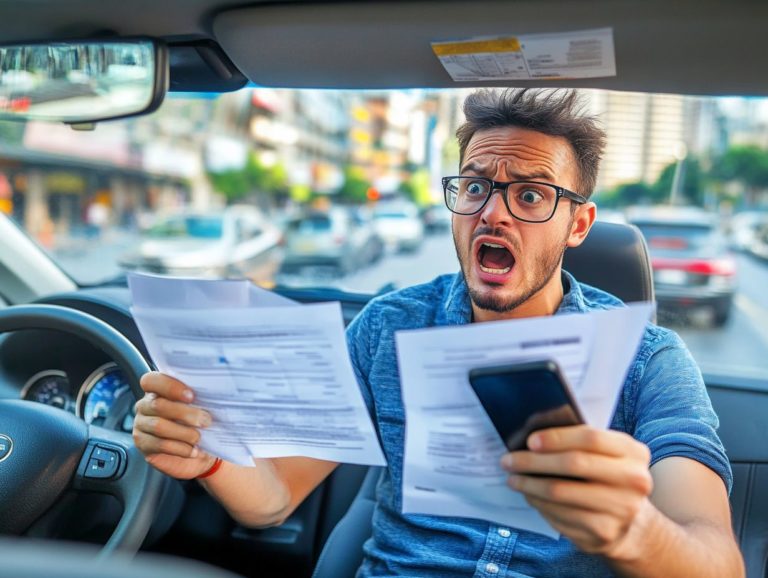What to Know About SR-22 Insurance for High-Risk Drivers
Navigating the world of car insurance can indeed be perplexing, particularly when it comes to SR-22 insurance. This specialized form of insurance is designed for high-risk drivers and often becomes necessary after certain violations, such as DUIs or repeated traffic offenses.
This article provides a comprehensive breakdown of everything you need to know about SR-22 insurance from its definition and who requires it to the steps for obtaining coverage and maintaining your policy. Grasping these key elements will empower you to make informed decisions and meet the requirements while on the road.
Contents
- Key Takeaways:
- Understanding SR-22 Insurance
- Who Needs SR-22 Insurance?
- How to Obtain SR-22 Insurance
- Costs and Coverage of SR-22 Insurance
- Maintaining SR-22 Insurance
- Requirements and Consequences of Non-Compliance
- Frequently Asked Questions
- What is SR-22 insurance and what does it mean for high-risk drivers?
- What are some common reasons why someone may need SR-22 insurance?
- How long do I need to have SR-22 insurance?
- Do all insurance companies offer SR-22 insurance?
- Does SR-22 insurance cost more than regular car insurance?
- What happens if I don’t have SR-22 insurance?
Key Takeaways:

SR-22 insurance is specialized coverage for high-risk drivers, often required by the state after certain traffic violations or convictions.
Being classified as a high-risk driver does not automatically mean you need SR-22 insurance. Factors like DUIs, reckless driving, and multiple violations can determine the need for SR-22.
Obtaining SR-22 insurance typically involves contacting your insurance provider and filing the proper paperwork. It’s important to shop around for the best rates and coverage.
Understanding SR-22 Insurance
Understanding SR-22 insurance is essential for drivers who have faced specific driving violations. This form of auto insurance guarantees that you are meeting the requirements of financial responsibility laws set by your state.
Typically mandated after serious offenses such as DUI (driving under the influence) or DWI (driving while intoxicated), the SR-22 form acts as a certificate of financial responsibility. It signals to the Department of Motor Vehicles (DMV) that you have the minimum coverage needed to drive legally.
What is SR-22 Insurance?
SR-22 insurance is a specialized form of auto insurance that serves as a certificate of financial responsibility. It s your way of proving to state authorities that you meet the minimum coverage requirements to drive legally.
You ll often encounter this type of insurance if you’ve faced serious violations, such as DUI offenses or repeated traffic infractions, which require reinstatement of your driving privileges. The requirement for SR-22 varies by state; some jurisdictions may mandate it for specific durations after an incident.
By maintaining your SR-22 status, you’re not only meeting the state laws but also ensuring that you avoid lapses in your auto insurance coverage.
Keeping your auto insurance valid is vital! It protects you from penalties and ensures peace of mind.
Who Needs SR-22 Insurance?
You may find yourself needing to secure SR-22 insurance, especially if you’re considered a high-risk driver. This typically applies to those who have committed driving violations such as DUI or DWI or have faced multiple traffic offenses that jeopardize their eligibility for a valid driver’s license.
Factors that Determine the Need for SR-22

The need for SR-22 insurance depends on several factors, such as your driving history, the severity of any offenses, and the financial responsibility that state law requires of you.
Your insurance rates often reflect how frequently incidents have occurred, along with the nature of those infractions think DUIs or reckless driving. If you maintain a clean driving record, you’re likely to enjoy lower premiums and better liability coverage options. Conversely, a history of violations can lead to significantly increased costs of coverage.
States typically require this type of insurance for individuals classified as high-risk, making it essential to assess your situation comprehensively to understand how past behaviors may influence your future insurance requirements.
How to Obtain SR-22 Insurance
Obtaining SR-22 insurance requires navigating a few essential steps. Begin by reaching out to an insurance company or agent to kick off the process.
It’s important to familiarize yourself with the filing fee tied to the SR-22 form and ensure that your policy aligns with your state s specific coverage requirements.
Steps to Getting SR-22 Coverage
To obtain SR-22 coverage, you must navigate clear steps, starting with selecting an insurance agent who specializes in high-risk insurance policies. Ensure that your chosen policy meets state-mandated coverage limits.
This initial choice is vital. A seasoned agent will expertly guide you through the complexities of the process. Next, gather all necessary documentation, such as proof of identification and previous insurance records, to facilitate a seamless application process.
Once your agent has assessed your needs, take the time to review various coverage options. Pay close attention to policy limits and exclusions. Understanding these details will help you avoid unexpected costs down the line.
Make timely payments and keep your coverage continuous to protect your driving privileges. This is essential to prevent lapses that could jeopardize your rights to drive.
Costs and Coverage of SR-22 Insurance
The costs tied to SR-22 insurance can fluctuate significantly, influenced by various factors. Your driving history plays a significant role, along with the regulations of your state and the specific liability coverage required.
All these elements collectively impact your overall insurance premiums and any applicable filing fees.
Factors that Affect Cost

Several factors can influence the cost of your SR-22 insurance premiums. These include your history of traffic violations, especially any DUI incidents, and the overall quality of your driving record.
Beyond these elements, the nature and frequency of your past accidents carry significant weight. Insurance providers closely examine various aspects, such as the number of claims you’ve filed over time and the severity of those claims. This can ultimately determine how much you pay.
Additionally, where you live plays a role in premium rates. Areas with higher crime rates or accident statistics often lead to increased costs.
Lastly, the insurance company you choose can impact the price, as each provider has its own methods for assessing risk and determining premiums.
Types of Coverage Available
The types of coverage available with SR-22 insurance include standard liability coverage, which is essential for all drivers, and specific non-owner policies designed for those without a personal vehicle.
These coverage options are vital not just for legal compliance, but also for protecting yourself against any financial repercussions that could arise from accidents. Liability coverage typically includes bodily injury and property damage, providing a safety net against claims arising from an at-fault accident.
Non-owner policies, on the other hand, are ideal for individuals who frequently rent cars or borrow vehicles. They allow you to maintain valid insurance without owning a personal car. This flexibility is crucial for anyone who drives intermittently, ensuring you remain in good standing with state requirements and avoid penalties.
Maintaining SR-22 Insurance
To maintain your SR-22 insurance, follow these strict rules to avoid losing your driving privileges. You must adhere to the stringent requirements established by both your insurance provider and state laws.
Stay informed and diligent to keep driving without worries.
Requirements and Consequences of Non-Compliance
The requirements surrounding SR-22 insurance are clear. You must maintain continuous coverage without any lapses. If you don t follow this rule, it can lead to serious issues that negatively affect your driving record and delay the reinstatement of your driver’s license.
It s important to understand that SR-22 isn t an insurance policy on its own; it s a certification demonstrating that you have the minimum liability coverage mandated by the state. If you allow your policy to lapse, your insurer is required to notify the state. This can result in an immediate suspension of your driving privileges and complicate matters further, as any violations will be recorded on your driving history. This makes it harder for you to reinstate your license down the line.
You must keep your SR-22 coverage active to regain your driving freedom.
Frequently Asked Questions

What is SR-22 insurance and what does it mean for high-risk drivers?
SR-22 insurance is a type of proof of financial responsibility that is required for high-risk drivers. It is a certificate filed by an insurance company with the state, showing that the driver has the minimum amount of liability coverage required by law.
What are some common reasons why someone may need SR-22 insurance?
Some common reasons for needing SR-22 insurance include driving under the influence (DUI) or driving while intoxicated (DWI), multiple traffic violations or accidents, and driving without insurance.
How long do I need to have SR-22 insurance?
The length of time you need SR-22 insurance varies by state and your specific circumstances. In general, you will need to have it for at least three years, but it could be longer depending on your state’s laws.
Do all insurance companies offer SR-22 insurance?
No, not all insurance companies offer SR-22 insurance. It is typically offered by high-risk or non-standard insurance companies. You may need to shop around and compare quotes to find the best SR-22 insurance policy for you.
Does SR-22 insurance cost more than regular car insurance?
Yes, SR-22 insurance typically costs more than regular car insurance. High-risk drivers are considered more likely to file a claim and are charged higher premiums to offset this risk.
What happens if I don’t have SR-22 insurance?
Missing out on SR-22 insurance can lead to severe consequences! You could face license suspension, hefty fines, or even jail time so don t take this lightly. It’s important to comply with the requirements and maintain your SR-22 insurance until it is no longer needed.
Stay informed, stay covered, and drive safely!





